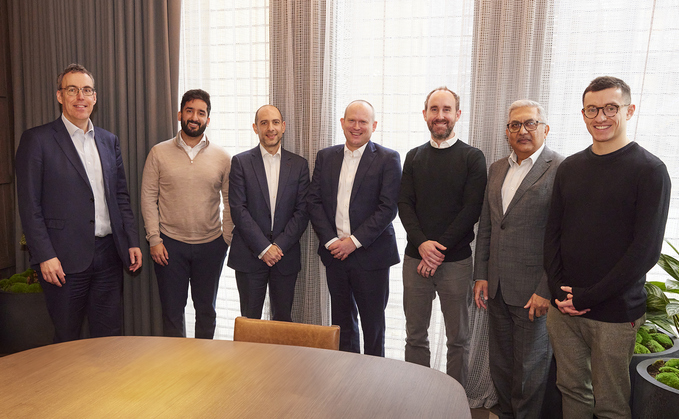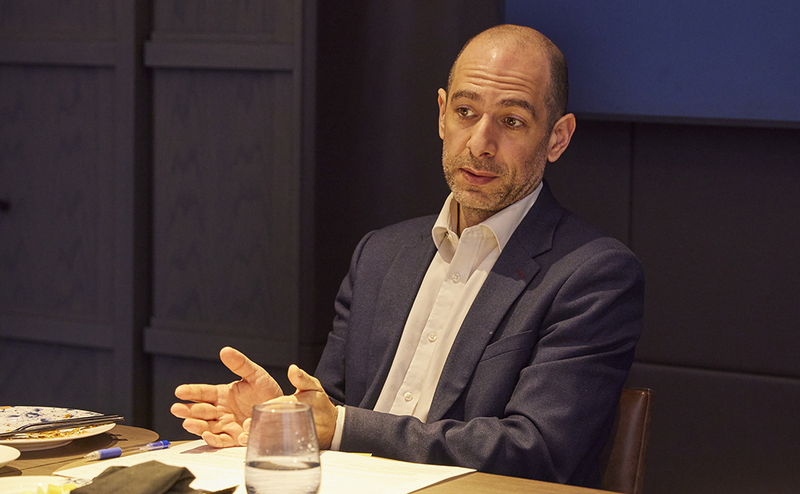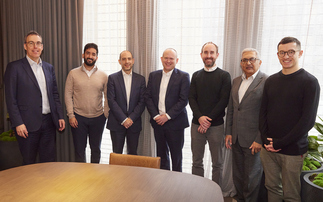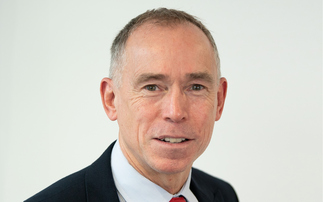
The panellists were (left to right): PP editor Jonathan Stapleton; Mobius Life director of asset manager solutions Joshun Sandhu; Columbia Threadneedle Investments institutional business director Andrew Brown; XPS Pensions Group head of DC investment Mark Searle; Aon partner Chris Inman; Independent Governance Group trustee director Dinesh Visavadia; and Cushon head of investment, Marc Barnett.
In March, Professional Pensions assembled a panel of experts to discuss the role of credit in defined contribution (DC) defaults and ask how fixed income can be used to deliver positive social, as well as financial, outcomes for members.
The roundtable – chaired by PP editor Jonathan Stapleton and held in association with Columbia Threadneedle Investments – also looked at whether more consideration should be given to social factors when investing for DC defaults and talked about how to measure and benchmark such strategies as well as the benefits of taking a global approach.
To start us off, how is credit currently being used in DC default strategies and how can it best be used?
Chris Inman: For many years, UK portfolios were biased towards gilts. Today with less of an argument to invest in gilts and a much broader opportunity set for DC investors, we have moved clients into more globally focused portfolios with multi-asset credit (MAC) providing a good, flexible exposure to credit markets.
We also consider asset-backed securities (ABS). Lots of people would have been nervous about investing in ABS ten or 15 years ago, and rightly so, but increased regulation and liquidity, the extra ability from rating agencies to look through these assets, and a yield pick-up makes a difference. ABS can also help with social impact investing.
Mark Searle: With ABS, you often have a lower-duration exposure to credit markets, which is helpful when you recall events like the gilt crisis in 2022. We think of credit as being low-risk assets for use after the high-equity growth stages of retirement saving, but when a member approaches the end of that journey and the bond is marked to market in the now higher-yield environment, they actually present risks. Being mindful of which bonds are in the portfolio is important.
Marc Barnett: In our DC default strategy, we have a 10% credit allocation in our growth phase, which has been a decent diversifier from equities. We have focused on some short-duration MAC and active impact bonds. While impact bonds can potentially outperform or underperform, there is value in the engagement opportunities these assets present.
Dinesh Visavadia: As a trustee, we look through the member lens. We think about simplicity and the message we give. Asset managers put together wonderful models and say, ‘What is the lowest risk and the return?' but explaining that to a member is hard work.
We need more education. We need to change some of the ways in which we present this. If you go to a wealth manager, they have layers of risk – low, medium and high – and you just choose one. Obviously, they do not do that in discretionary portfolios. We need to bring these two ideas together, which would be more beneficial for members in terms of their outcomes.

Joshun Sandhu: We have also seen a lot of movement to investment grade (IG) credit. We have a lot of instances where schemes are buying a total return credit from a manager, and outsourcing the problem of choosing the type of credit makes sense.
In DC default funds, we have seen some but not a lot of active impact bond investments. When it comes to the active budget in a portfolio, a lot of the discussions are around private market investments. On the social side, there may be increased opportunities to directly fund projects that can have certain impacts, but the question is then how easy is it to report in the private versus the public space?
Andrew Brown: Credit has a strong role to play in enabling trustees, governance bodies and members achieve their ESG objectives and risk-return targets through the various parts of the glidepath. We pioneered social bonds funds over ten years ago in the UK. Through our deep understanding of the UK fixed income market, and experience in investing for positive outcomes, we enable clients to capture the twin reward of social and financial benefit. In this instance, daily pricing, liquidity and tradability is made available for impact investing.
Bonds should play a more significant role in helping schemes meet responsible investment strategy and targets, and the impact created by bonds (use of proceeds) is arguably more measurable than with equity holdings.
Marc Barnett: If you own, for instance, a small slice of Tesco equity, it is hard to know exactly what your investment is doing. But if you invest in Tesco's sustainability-linked bond, you can see the key performance indicator (KPI) and you have a more measurable impact. I do not think that you are sacrificing returns. There are clearly structural tailwinds to impact investing, as investors and policymakers realign capital towards a more sustainable world. But the main value we get is engagement. If you can point to a specific KPI, that has a lot of value in telling people that their pension is not just a number but is doing some good real-world things.
Chris Inman: There's a lot of ‘carbon tunnel vision' in the industry, for various reasons, including the ease of reporting metrics. Credit and social impact have a place in default strategies – indeed interlinking investment returns and member communication/engagement is so important in getting members to engage with their portfolios. Showing members that their DC savings are doing good can engender pride in their pension and in their employer.
Mark Searle: I think we have been too focused on environmental issues, and social has come late to the party. All businesses cause and are affected by social factors and when those social factors are financially material, it should form part of the investment decision. As a consultancy, we need to make sure that any focus on social good aligns with our clients' needs and views, and those of the sponsors.
Dinesh Visavadia: With climate change, there is a framework and universal agreement of the targets. When you look at the other sustainability directives, there is no framework. It would be nice to see what social impact means for people. But it poses a problem from a trustee standpoint too. If 20 of your members are telling you, ‘We do not like this particular fund', or ‘We want this particular fund', it is difficult to ignore that feedback.
It is easy to influence others that particular stocks or sectors are not a good idea – as we have seen with the movement to abolish tobacco investment from Superfunds in Australia - but exclusion is not the solution. Engagement is the right answer, but as trustees we struggle to do that because managers need specific guidelines.
How are managers approaching social factors in investing?
Andrew Brown: We have developed a framework for delivering social outcomes by working closely with social partners; Big Issue Invest in the UK, to shape a social universe. We identify categories of bonds with higher potential for delivering social outcomes and alignment with UN Sustainable Development Goals. Our approach focuses on positive inclusion; bonds are assessed against a screening criterion and includes considerable engagement with issuers.
The industry would perhaps be helped by universally accepted metrics for measuring social impact. Environmental impact assessment is helped using carbon emissions and targets, such as a 2040 or 2050 net-zero commitment.
Social Impact reports are produced annually - it can be done, but it is less standardised.

Joshun Sandhu: We invest with 80 asset managers in 700 funds and have done quite a lot of work on trying to collect ESG and Taskforce on Climate-related Financial Disclosures (TCFD) data from managers. We ask about key engagements and they are explained, but if you put all that in a report it can be 20 or more pages long.
Is reporting on the social side bespoke depending on which manager you invest with and what their strategy is?
Joshun Sandhu: It is. We ask a lot of questions around key engagements and the topic of votes – diversity and inclusion, for example – and we try to get an idea of the issues. We have used a third party to build a digital questionnaire for managers, but it is not perfect as you are still reliant on asset managers providing the right quantitative and qualitative data. Out of 80 asset managers, at most 50 are using it currently.
Marc Barnett: There are so many metrics you can track. For our social impact bond fund, each bond targets its own metric, for example, financial inclusion, access to water or affordable housing. They are almost all bespoke, so I do not know how you would aggregate all of that into a digestible questionnaire.
Andrew Brown: From a manager's perspective, we get asked similar, but not identical questions from consultants, schemes and platforms that we work with. It would be great to receive more feedback given the resource and effort required to build the functionality. I understand these are largely meeting regulatory governance requirements, but I would like to think the data is being used to communicate in a format that members can engage with.
Mark Searle: The right place to include this information to get it in front of members is perhaps within the implementation statement, but I do not think that members know these documents exist or that they are particularly understandable. Getting the right information in the right way to the membership is a problem.
Chris Inman: We had a case study linking the UN sustainable development goals (SDGs) with member engagement for World Plastic Free Day. On that day, everyone received emails from their company saying things like: ‘The plastics from the canteen have been removed. We are not using straws, etc.' But the next thing is to say: ‘Your pension scheme is investing in a company that uses plastic fished out of the ocean to make office furniture and one of those chairs is in the canteen.' You then provide a QR code that links to give more information.
It's about showing how to make a tangible difference and saying: ‘Your pension is helping to do this'.
How important are these sort of stories in engaging members? Do DC schemes need to be seen to be doing good as well as achieving good financial returns?
Dinesh Visavadia: Today's DC savers are young people who care a lot about the environment, and they want to do the right thing in their communities as well. We need to harness that enthusiasm.
Andrew Brown: We had an interesting conversation with a master trust where a majority of members are average and low paid workers. When surveyed, they found that tobacco and gambling – sectors excluded from their equity strategies – are not high on members' ESG agendas.
Instead, they expressed concerns about labour standards or housing costs – social issues. This should perhaps play a greater role in members' default strategies.
Dinesh Visavadia: We know what individuals want, but when you start amalgamating a variety of views into a single default fund, it becomes a problem. Getting rid of the default might help, because you can then create a spectrum of impacts and say to members: ‘You choose'. We should not let members off for not making that decision.
Chris Inman: Financial materiality is the number one fiduciary duty. There will always be individual requests from members, but we need to be careful not to be distracted from financial materiality. If impact investing makes sense financially and if we can engage members, that is great, but we are not necessarily here to build a default strategy that will please everyone. What we are trying to do is get good member outcomes.

Mark Searle: You can do surveys and find out the broad themes that are important for your membership. However, it is going to be an average. If you are really going to address specific member needs, perhaps it is through the self-select range. But you are not going to cater for everything and everyone, because you are not trying to build a fund supermarket.
Marc Barnett: We have probably the highest app download rate of any master trust, but we struggle to get member engagement and feedback. A lot of our members just click to see what their pot size is in any given week or month, and then close it again. They can give indicative votes directly on the app, but we only get a 5%-10% take up. Getting them engaged is much better done with stories. If you tap into someone's emotion rather than a metric, it is much easier to foster that engagement.
Is there a premium for strategies investing in social bonds?
Andrew Brown: To be assessed for any potential positive societal impact, any bond or issuance first must meet our financial criteria. If an issuance is not beneficial to the financial returns of the portfolio it will not be included. It may be the case that non-financial characteristics of some bond leads to a ‘greenium', for example; however, we are investing in social bonds to provide an investment grade corporate bond return.
Mark Searle: It is fair to say that the management costs are higher, but the turnover costs are probably lower, because once a bond has made it into a social bond strategy, it likely stays there until maturity.
Are there benefits of going global when assessing credit generally and social bonds more specifically?
Chris Inman: Yes, for the access and the opportunity set. Restricting yourself makes no sense from an investment perspective.
Marc Barnett: All our impact bond funds are global. The opportunity set is already quite reduced versus global bonds, so why restrict it further? Impact stories are more poignant if they are in the UK, but that is not enough of an argument to go with a more localised strategy.
What are your key takeaways or concluding comments from this discussion?
Joshun Sandhu: From an investment perspective, there is an argument for credit. Then a decision should be made about the social element. If it is the case, we need to make it clear that schemes and members are not giving up performance to allocate to something like this.

Marc Barnett: We need to think a bit more carefully around what data we want and not overburden managers with all these requests. We need to think more carefully about what is really impactful and useful.
Dinesh Visavadia: Credit has a space in the investment strategy. Trying to do something on the social side is difficult. Climate is easier, because every country in the world has said that the target is about temperature. Socially, you cannot have that global policy. Hopefully, industries will unite and take advantage of some of the new innovations, which will help us achieve demonstrable social impact.
Chris Inman: First, we need to make sure that we do not get carbon tunnel vision and that we are using the full breadth of the investment opportunity set in front of us. Second, it's about data. Do not let a desire for perfection get in the way of doing something.
My final point is a rallying cry for everyone to work together. This should not be a competition between managers and consultants, it's about the greater good.
Mark Searle: We need to be clear that it is about making a financial return alongside a social impact. If you can have both, what is the downside of doing social good when you also are making the returns you need for your members?
Andrew Brown: We need an industry framework, and perhaps that ‘Blue Planet' moment in the social arena to bring it to the forefront. However, I agree, don't let perfection get in the way of progress. More effort needs to be put into this important asset class to ensure that portfolios can achieve societal impact and financial returns.
This roundtable was held on 13 March 2024 in association with Columbia Threadneedle Investments






